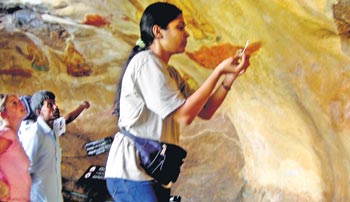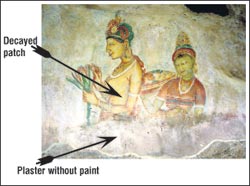
Damsels in distress?Scientists fear that the Sigiriya frescoes could face a bacteria attack.
Are bacteria which cause discolouration of frescoes, active at the magnificent 5th century AD World Heritage Site of Sigiriya? This is what a research scientist of the Central Cultural Fund (CCF) is attempting to ascertain through exhaustive studies and analysis. “We have confirmed our findings about 88%, but not 100%,” says research scientist Sanjanie Fernando who has from June 2005 carefully collected samples from the frescoes off the walls of the rock fortress built by patricidal King Kassyapa, nurtured cultures of bacteria, pored over the microscope and dug deep into earlier research and reference work.
Explaining that she may have “isolated” at Sigiriya the bacteria dubbed as ‘Bacillus decolorationis’ by investigators who had studied murals in Spain and Austria, Sanjanie hastens with the reassurance that these micro-organisms were found not on the pigmented (painted) sections of the frescoes but in three other areas – a decayed patch of the pigmented area, a section of non-painted plaster and a cavity of the non-pigmented plaster. How did Sanjanie – who is working under the guidance of Dr. Mohan Abeyratne, Director of the Research Laboratory of the CCF and Senior Lecturer Dr. D.L. Jayaratne of the Department of Microbiology, Faculty of Science, University of Kelaniya – stumble on these findings, which if confirmed would require not only more in-depth investigations but also urgent and long-term action to conserve the frescoes which are of national pride to Sri Lanka? Microbiological investigations began back in July 2000, when there was a scare that there was a fungal attack on the frescoes. It was Dr. Jayaratne who recommended periodic monitoring of the frescoes to prevent any harm being caused by a possible growth of such micro-organisms in the future, followed by a recommendation report to the Minister by Dr. Abeyratne …….and that is how the latest research on bacteria activity has come to light. Detailing how the research was carried out, Sanjanie says samples from each and every pigment of the frescoes were taken by rubbing tiny, sterilized cotton buds.“This was critical work because it had to be done very carefully, so as not to disturb or damage the frescoes,” she says, smilingly recalling how she sometimes got on a small stool to reach parts of the heavenly maidens that did not come within her height.
Then followed the nitty-gritty of microbiological investigations, followed by morphological and physiological observations by recording the colony characteristics, while subjecting the bacteria to staining to determine cell shape, cell arrangement, gram reaction and spore formation. They were also subjected to certain biochemical tests. Using the Bergey’s manual, an international standard in such studies, Sanjanie characterized the bacteria isolates while analyzing the test results based on a computer database developed by Trevor Bryant, University of Southampton, UK (2005). “The predominant isolates are the distinctive species of the genus Bacillus,” says Sanjanie, adding that a similar investigation recorded by Heyrman et al., in 2002 on bacterial species isolated from the mural paintings of the Servilia tomb in Spain and the Saint-Catherine Chapel in Austria concluded that the isolates belong to the species of the genus Bacillus and they have proposed the name Bacillus decolorationis sp. nov. for the new isolate. What is the significance of these findings for the beautiful Sigiri maidens? More studies, including DNA analysis, are required, stresses Sanjanie, before coming to a conclusion whether the bacteria will have an impact on the frescoes. “It is also crucial to remember that for centuries, there has been a balance among the different life forms on the frescoes. There is an eco-system there already.” Adds Dr. Abeyratne: “The need of the hour is continuous monitoring to determine whether such bacteria will cause damage to the frescoes.” One way of doing so is to regularly check each pigment against a standardized colour chart that is used for archaeological purposes worldwide. “Take the blue on a fresco, study it now and in a few months to check whether there has been a deterioration in the colour,” he says setting out the action plan. If and when such an eventuality arises, we will take all necessary action to conserve this World Heritage Site, he adds. |
|| Front
Page | News | Editorial | Columns | Sports | Plus | Financial
Times | International | Mirror | TV
Times | Funday
Times || |
| |
Copyright
2007 Wijeya
Newspapers Ltd.Colombo. Sri Lanka. |

